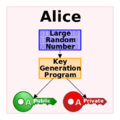Cryptography (nonfiction): Difference between revisions
No edit summary |
|||
| Line 15: | Line 15: | ||
<gallery mode="traditional"> | <gallery mode="traditional"> | ||
File:Cryptographic numen modelled as nano-wire.jpg|link=Cryptographic numen|[[Cryptographic numen]] modelled in nanowire. | File:Cryptographic numen modelled as nano-wire.jpg|link=Cryptographic numen|[[Cryptographic numen]] modelled in nanowire. | ||
File:Public key cryptography.png|link=Public-key cryptography (nonfiction)|Diagram of [[Public-key cryptography (nonfiction)|public-key cryptography generation]] refuses to disclose private key. | |||
</gallery> | </gallery> | ||
Revision as of 20:09, 7 December 2016
Cryptography (or cryptology; from Greek κρυπτός kryptós, "hidden, secret"; and γράφειν graphein, "writing", or -λογία -logia, "study", respectively) is the practice and study of techniques for secure communication in the presence of third parties (called adversaries).
More generally, it is about constructing and analyzing protocols that block adversaries.
Modern cryptography exists at the intersection of the disciplines of mathematics, computer science, and electrical engineering.
Cryptography prior to the modern age was effectively synonymous with encryption, the conversion of information from a readable state to apparent nonsense.
The originator of an encrypted message shared the decoding technique needed to recover the original information only with intended recipients, thereby precluding unwanted persons from doing the same.
Since World War I and the advent of the computer, the methods used to carry out cryptology have become increasingly complex and its application more widespread.
In the News
Cryptographic numen modelled in nanowire.
Diagram of public-key cryptography generation refuses to disclose private key.
Fiction cross-reference
- Cryptographic numen - a numen (nonfiction) arising from cryptography.
- Casio + N = CasiNo
Nonfiction cross-reference
External links:
- Cryptography @ Wikipedia
- Cryptography @ Wikipedia


